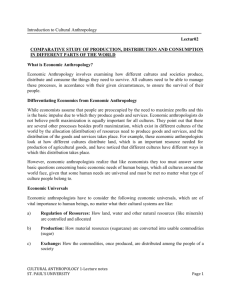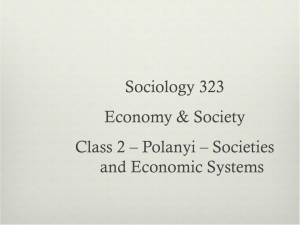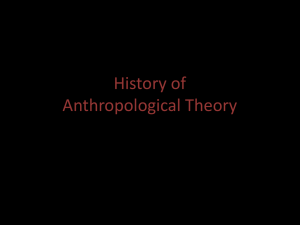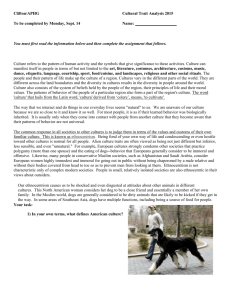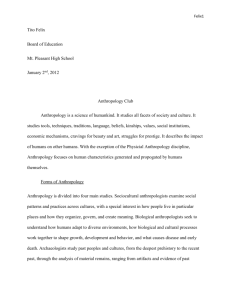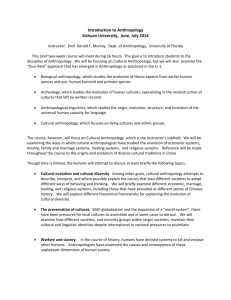the distribution of goods and services
advertisement
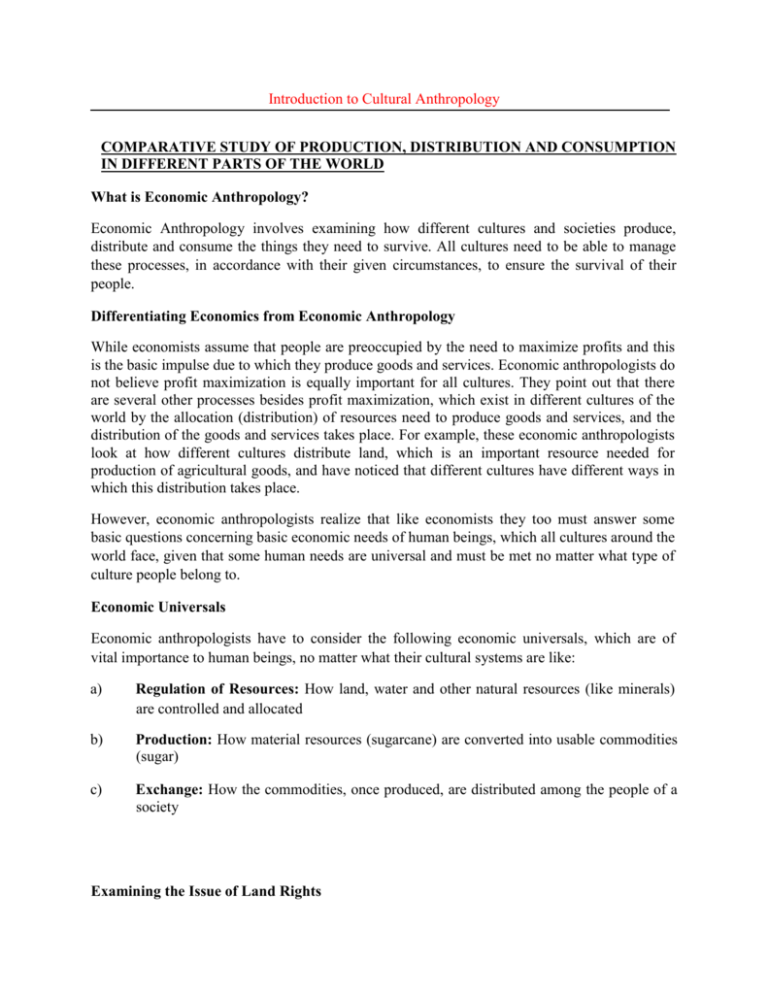
Introduction to Cultural Anthropology COMPARATIVE STUDY OF PRODUCTION, DISTRIBUTION AND CONSUMPTION IN DIFFERENT PARTS OF THE WORLD What is Economic Anthropology? Economic Anthropology involves examining how different cultures and societies produce, distribute and consume the things they need to survive. All cultures need to be able to manage these processes, in accordance with their given circumstances, to ensure the survival of their people. Differentiating Economics from Economic Anthropology While economists assume that people are preoccupied by the need to maximize profits and this is the basic impulse due to which they produce goods and services. Economic anthropologists do not believe profit maximization is equally important for all cultures. They point out that there are several other processes besides profit maximization, which exist in different cultures of the world by the allocation (distribution) of resources need to produce goods and services, and the distribution of the goods and services takes place. For example, these economic anthropologists look at how different cultures distribute land, which is an important resource needed for production of agricultural goods, and have noticed that different cultures have different ways in which this distribution takes place. However, economic anthropologists realize that like economists they too must answer some basic questions concerning basic economic needs of human beings, which all cultures around the world face, given that some human needs are universal and must be met no matter what type of culture people belong to. Economic Universals Economic anthropologists have to consider the following economic universals, which are of vital importance to human beings, no matter what their cultural systems are like: a) Regulation of Resources: How land, water and other natural resources (like minerals) are controlled and allocated b) Production: How material resources (sugarcane) are converted into usable commodities (sugar) c) Exchange: How the commodities, once produced, are distributed among the people of a society Examining the Issue of Land Rights Free access to land is found in environments where water and pasturage is scarce. Land rights are more rigidly controlled among horticulturalists and agriculturalists than among foragers and pastoralists. Division of Labor Durkheim (the famous sociologist, responsible for establishing this branch of study in the early twentieth century) had distinguished between two types of societies, those based on mechanical solidarity and others based on organic solidarity. Societies with a minimum specialization of labor are held together by mechanical solidarity, based on commonality of interest. In these societies, people are more self-reliant, therefore, they need other people to a lesser degree than people in societies where people focus on production of a very specific good or service and then rely on others to provide them other necessities of life in exchange for their specialized product. Highly specialized societies are held together by organic solidarity, based on mutual interdependence. Such societies emphasize the need for specialization and people depend on other people in order to obtain the different things that they need. Gender Roles and Age Specialization Generally, many cultures allocate specific responsibilities on the basis of age and gender. Ole people and those very young are given lighter tasks in most cases, where circumstances permit (in cases of extreme poverty, child labor can also take place). Similarly, women are usually allocated tasks which allow them to maintain flexible timings so that they can look after their homes as well. There are exceptions to this rule however, since many educated women do work as long as men, often leaving their children to the care of day centers. In many countries around the world, the process of urbanization has led men to move away to the cities in order to earn more cash, often leaving women behind to undertake agricultural work, which was previously done by men. Circumstances also compel poor women to take on heavy work burdens, like their men folk, to ensure the survival of their families. Moreover, the same type of activity (weaving) may be associated with the opposite gender in different cultures; the division of labor by gender is seen as being arbitrary. Is Nepotism Always Bad? In many societies people relate to each other based on the principle of particularism (family and kinship ties) rather than on universalistic terms (using standardized exams, interviews). Nepotism is not necessarily a sign of corruption, since consideration of ground realities like kinship ties can often help determine how people will adjust to specific work environments. Useful Terms Allocation of resources: the distribution of resources. Barter: the direct exchange of commodities between people that does not involve a standardized currency. Division of Labor: the set of rules found in all societies dictating how the day to day tasks are assigned to the various members of a society. Reciprocity: the practice of giving a gift with an expected return. Globalization: the world wide process dating back to the demise of the Berlin wall, which involves a revolution in information technology, opening of markets, and the privatization of social services. Labor specialization: a form of having command over one activity. Suggested Readings Students are advised to read the following chapters to develop a better understanding of the various principals highlighted in this hand-out: Chapter 8 in ‘Cultural Anthropology: An Applied Perspective’ by Ferrarro and/or Chapter 17 in ‘Anthropology’ by Ember and Pergrine THE DISTRIBUTION OF GOODS AND SERVICES Modes of Distribution Economic Anthropologists categorize the distribution of goods and services in three modes; reciprocity, redistribution and market exchange. Based on these three forms of exchange, cultures around the world distribute the goods and services produced by them, in order to ensure the survival of the various people which belong to that particular culture. 1. Reciprocity implies exchange of goods and services of almost equal value between two trading partners. 2. Redistribution, most common in societies with political bureaucracies, is a form of exchange where goods and services are given by a central authority and then reallocated to create new patterns of distribution. 3. Market exchange systems involve the use of standardized currencies to buy and sell goods and services. Types of Reciprocity The idea of reciprocity can be divided into the following distinct types of practices evident in cultures around the world: 1. Generalized reciprocity involves giving gifts without any expectation of immediate return. For example, the parents look after their children and these children, when they grow older look after their aging parents. This is an unsaid rule or obligation towards one family, which people undertake willingly out of love and concern and without any external compulsion or the idea of getting something back in return for their caring attitudes. 2. Balanced reciprocity involves the exchange of goods and services with the expectation that the equivalent value will be returned within a specific period of time. For example, if a neighbor’s son or daughter is getting married, the neighbors will take gifts to the wedding, and then expect the same courtesy when their own child’s wedding. The notion of birthday gifts is even more time specific, and thus serves as a good example of balanced reciprocity. 3. Negative reciprocity involves the exchange of goods and services between equals in which the parties try to gain an advantage, in order to maximize their own profit, even if it requires hard-bargaining or exploiting the other person. Redistribution Whereas reciprocity is the exchange of goods and services between two parties, redistribution involves a social centre from which goods are redistributed. Often this redistribution takes place through a political or bureaucratic agency (e.g. the revenue collection or tax department which is found in most countries or even the zakat system in Pakistan, based on a religious ideology, which is meant to redistribute wealth to those who are destitute). Market Exchange Market exchange is based on use of standardized currencies or through the barter (exchange) of goods and services. This system of exchange is much less personal than either reciprocity or redistribution. People trade in a marketplace to maximize their profits. The greater the specialization of labor that exists in a society, the more complex is the system of market exchange to be found in that society. Globalization Globalization involves the spread of the free-market economies to all parts of the world based on the assumption that more growth will take place when free trade and competition becomes a universal phenomenon. Globalization has begun to show visible impacts on the cultures and lives of people around the world. There are people who favor globalization, thinking it will help remove poverty across much of the world, but they are also those who think that globalization will do the exact opposite. Useful Terms Organic Solidarity: a type of social integration based on mutual inter-dependence. Particularism: the propensity to be able to deal with people according to one’s particular relationship to them rather than according to a universal standard. Production: a process where by goods are taken from the natural environment and then altered to become consumable goods for society. Property Rights: western concept of individual ownership. Standardized Currency: a medium of exchange with well defined and an understood value. Universalism: the notion of awarding people on the basis of some universally applied set of standards. Suggested Readings Students are advised to read the following chapters to develop a better understanding of the various principals highlighted in this hand-out: Chapter 8 in ‘Cultural Anthropology: An Applied Perspective’ by Ferrarro and/or Chapter 17 in ‘Anthropology’ by Ember and Pergrine FOCUSING ON LANGUAGE An Anthropological Perspective Language is a unique phenomenon, which allows human beings to communicate meaning to others and express our thoughts and feelings to other people. Perhaps the most distinctive feature of being human is our capacity to create and use language. Many anthropological linguists would agree that without language, human culture could not exist beyond a very basic level. The Nature of Language The meaning we give to language is arbitrary (random). It is due to this arbitrary nature of language, there is such a diversity of languages. Languages of the World Almost 95 percent of people speak fewer than 100 languages of the approximately 6,000 languages that are currently found in the world. Due to this, many languages face the threat of extinction, with an increasingly small number of people who know the language. This evident dying out of rarely spoken languages is an issue of concern to cultural anthropologists since the extinction of a language also means the death of a way of thinking and expressing human thought. Of the more widely spoken languages, Mandarin (Chinese dialect) is spoken by almost 1 in 5 people in the world. Hindi is also spoken by multitudes of people. Yet, English is the most popular second language spoken by people all around the world. Communication – Human versus Nonhuman Humans are not the only species that communicate. Animals use calls to mate, find food and signal danger. Human communication amongst humans is however much more complex than that of animals. We can combine words in unique ways, to express our innermost feelings or even very complicated ideas which can be understood by others who can speak the same language. Open and Closed Communication Systems Animal sounds are mutually exclusive (Closed Communication systems), they cannot be combined to express new meanings. A warning sound of an animal is always the same and this sound is used to convey the same message always, it cannot be combined with other sounds to convey different types of meaning. Only humans can put different meanings together (through using of an Open Communication system, which is the language they speak). This categorization of Open and Closed communication systems has been questioned by anthropological linguists, based on research conducted using sign language. A chimpanzee for example can in fact combine two words to create a third word. Researchers have trained a chimpanzee to learn the sign language for ‘water’ and for ‘bird’ but not shown it how to say ‘duck’ using sign language. This chimpanzee has however been able to create the two known words, ‘water’ and ‘bird’ to refer to a ‘duck’, indicating that other species could also use open communication systems like humans. However, no linguist has yet made the claim that any animal species has evolved language to a degree which can express the complexities of meaning that human beings can. Displacement Humans can speak of purely hypothetical and abstract things, of things which happened in the past or may happen in the future. Whereas animals only communicate in the present about things concerning their immediate surroundings, animals cannot express abstract thoughts. Learning to Communicate Imitating adult speech is partially responsible for acquisition of language. Linguists (like Noam Chomsky at the Massachusetts Institute of Technology) think that children are born with a universal grammatical blueprint, which helps them pick up the rules of the language being spoken around them so quickly, and that this is a biological gift that only the human species seems to possess, since no other species has such complex communication abilities. Structure of Language All languages have logical structures or rules, which are followed by all those who can speak, read and write that particular language. • Phonology: provides the sound structure to a language so it can be commonly understood when spoken. • Morphemes: the smallest units of speech that convey meaning (art-ist-s) by standing alone or being bound to other words • Grammar: provides the unique rules of a language, which help give a logical structure to a language. Grammar also provides rules by which words are arranged into sentences (syntax). Consider the words: Adam apples likes eating, which make no sense since the verb ‘eating’ and the adjective ‘likes’ are not in their grammatically correct position. Correcting the mistake will make the sentence clear: Adam likes eating apples. The underlying structure of sentences which enables us to correct such a mistake and speak in a clear manner is due to the grammatical rules of syntax. The fact that we can even say this sentence is due to phonology and morphemes help us create a sentence by providing us with different meanings in smaller words (eat-ing, like-s). Useful Terms Displacement: the ability that humans have to talk about things remote in time and space. Free Morphemes: morphemes that appear in a language without being attached to other morphemes. Grammar: the systematic way in which sounds are combined in any given language to send and receive meaning-full utterances. Phonology: the study of language’s sound system. Changes in Language Language evolves over time. Linguists can undertake a synchronic analysis to understand language structures and its underlying rules at a given point in time. Undertaking a diachronic analysis, however, means looking at how a given language changes over time. Language Families Language families include languages derived from a proto-language. Linguists began clustering languages upon finding similarities between Sanskrit and classical Latin and Greek in the 1880s. From the perspective of language families, Germanic is mother tongue of English. French and Spanish are its sister languages. They all belong to the Indo-European language family. All languages have internal dialects as well as sharing features with other languages as well, particularly with those belonging to the same language family as them. Levels of Complexity Linguists have proven that languages of less technological societies are as capable of communicating abstract ideas as advanced societies. For example, the Navaho do not have singular and plural nouns, like English does, but their verbs contain much more information than English. Instead of merely saying ‘going’ the Navaho say how they are going, if they are going on a horse, they must further indicate how fast the horse is going, which is a lot more information than a phrase in English, which just mentions ‘I am going’. Cultural Emphasis The vocabulary of languages emphasizes significant words in a given culture. This is known as a ‘cultural emphasis’. Technologically related words show emphasis on technology in highly industrialized countries. There are numerous new words to describe computer technology in various languages, which did not even exist a few decades ago. Language and Culture Some ethno-linguists suggest that language is more than a symbolic inventory of experiences from our physical world experiences. According to them, language even shapes our thoughts and provides a standardized way to react to experiences. The Sapir-Whorf Hypothesis According to this hypothesis, different cultures see the world differently due to their different languages. Language influences and channels our perceptions and thus shapes our resulting behavior as well. The hypothesis has conducted several tests in the attempt to validate its claim. Linking Language to Culture It is difficult to establish causation to prove either that language determines culture or that culture influences language. Language does mirror values of a culture, consider for example the emphasis on self in individualistic societies. On the other hand, in more traditional societies like Japan the use of collective words like ‘we’ is much more evident. Socio-Linguistics Socio-linguistics examines links between languages and social structures. While earlier cultural linguists focused on language structures, there is now greater focus on the situational use of language, i.e. how the same language is used to speak in different manners depending on the context of the conversation. Diglossia Often two varieties of the same language are spoken in different social situations. High forms are associated with literacy and education, and the elite whereas the lower forms (for example, Pidgin) are considered to be less sophisticated. Language and Nationalism Language has important implications for ethnic identities. To forge national unity, political leaders have often suppressed use of local languages in favor of standardized national languages to provide a sense of unity to the nation and to develop a common means of communication. Useful Terms Evolve: Develop Synchronic Analysis: the analysis of cultural data at a single point in time, rather than through time Diachronic Analysis: the analysis of socio-cultural data through time, rather than at a single point in time Derived: taken from Abstract: Not clear or vague Emphasis: To lay importance on Perceptions: Viewpoints Suppressed: concealed or covered up Dialect: form of speech peculiar to particular region Suggested Readings Students are advised to read the following chapters to develop a better understanding of the various principals highlighted in this hand-out: Chapter 6 in ‘Cultural Anthropology: An Applied Perspective’ by Ferrarro and/or Chapter 15 in ‘Anthropology’ by Ember and Pergrine
